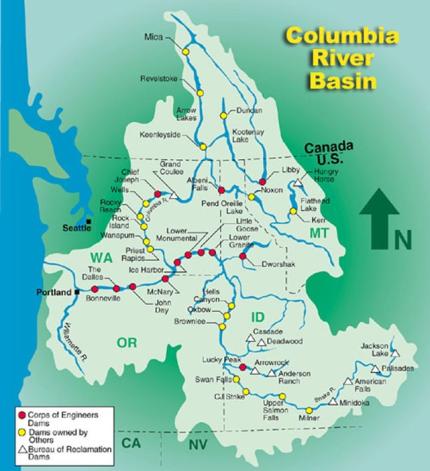
There are nine federally owned and operated hydropower dams on the mainstem Columbia and lower Snake rivers in Washington, and several other dams on the Yakima River, upper Snake River, and other Columbia River tributaries. The first mainstem Columbia River dam, Bonneville Dam, was finished in 1938. The last project, Lower Granite Dam on the lower Snake River, was completed in 1975.
Impacts on ESA-listed species
These dams hinder the migration of juvenile and adult fish. They increase fish mortality even where fish passage exists and have damaged habitat for fish and wildlife in the Basin. The projects created reservoirs that allowed some non-native fish, like smallmouth bass and walleye, to thrive. They have also created unnaturally favorable conditions for certain native salmon predators such as northern pikeminnow, various bird species, and sea lions.
The effects of the hydropower system on species listed under the Endangered Species Act (ESA) have been evaluated repeatedly since salmon and steelhead were first listed in the Basin in the 1990s. Dam operations/mitigation plans have been in litigation ever since. In 2022, The federal government entered into mediation with all parties involved in litigation.
Agreements and litigation
The mediation resulted in two major agreements in late 2023. First, the upper Columbia River tribes – including the Colville, Spokane, and Coeur D’Alene tribes, secured an agreement from the federal government to fund important steps toward the permanent reintroduction of salmon on the Columbia River above Chief Joseph and Grand Coulee dams. Grand Coulee Dam has blocked fish passage into the upper reaches and tributaries of the Columbia River for over 80 years.
Second, a coalition of environmental and fishing organization plaintiffs led by the National Wildlife Federation, their co-plaintiffs the State of Oregon, and plaintiff-intervenors the Nez Perce Tribe were joined by the State of Washington, the Confederated Tribes and Bands of the Yakama Nation, the Confederated Tribes of the Umatilla Indian Reservation, and the Confederated Tribes of Warm Springs in reaching an agreement with the federal government to stay the litigation for up to 10 years. This agreement was announced in mid-December 2023 and was accepted by the court on Feb. 8, 2024.
Recent happenings
- Columbia River Task Force announcements and documents
- Columbia Basin Restoration Initiative (PDF): a roadmap created by the six sovereigns for restoring the Columbia River Basin
- United States Government Commitments (PDF): In response to the six sovereigns Columbia Basin Restoration Initiative
Additional information
- Pacific Northwest Hydropower for the 21st Century Power Grid | Northwest Power and Conservation Council (nwcouncil.org)
- Information on the Columbia River Dams operated by the US Army Corps of Engineers: Columbia River Basin Dams (army.mil)
- The Fish Passage Center provides technical assistance and information to fish and wildlife agencies and tribes, in particular, and the public in general, on matters related to juvenile and adult salmon and steelhead passage through the mainstem hydrosystem in the Columbia River Basin.
- Columbia River System Operations Final EIS (army.mil)
- Analysis of effects of the Federal Hydropower system on species listed under the Endangered Species Act: Federal Columbia River Power System Biological Opinion | NOAA Fisheries
Public Utility District projects
Several projects on the mainstem Columbia River and tributaries are owned and operated by public utility districts. These projects are licensed via the Federal Energy Regulatory Commission (FERC), and those licenses are issued for a term of 30 to 50 years. The Federal Power Act grants state water quality regulators the authority to place water quality conditions in federal dam licenses, and requires consultation with state fish and wildlife agencies like WDFW the ability on mitigation and enhancement measures to reduce the impacts of non-federal hydropower dams.
Fish and wildlife mitigation agreements are generally negotiated directly with WDFW and included in the FERC license. Agreements run with the project license term, sometimes in perpetuity. The Washington Department of Fish and Wildlife consults with state and federal agencies, project operators, tribes, and stakeholders during the creation, implementation, monitoring, and adaptive management required by the operating license measures issued by FERC.
Learn more
- Abundance and Migration Success of Overshoot Steelhead in the Upper Columbia River - Murdoch - 2022 - North American Journal of Fisheries Management - Wiley Online Library
- Mid-Columbia Habitat Conservation Plans and associated biological analyses and permits: Rocky Reach, Wells and Rock Island (Mid-Columbia) Habitat Conservation Plans | NOAA Fisheries
- Priest Rapids Project Salmon and Steelhead Settlement Agreement (PDF)
- Cowlitz River Project
- Lewis River Project